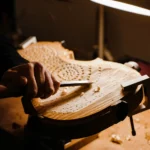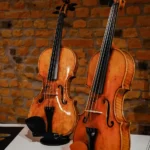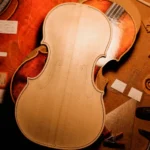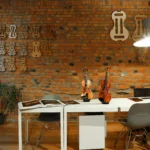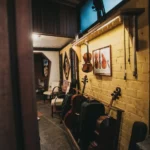Exploring The Different Violin Models
Back to BlogViolin models seem to be a hot topic in the violin community, particularly for newcomers who are looking to make the leap from renting (or borrowing a student instrument) to making their first major purchase. But why do violins have different models? Here are some things to help you better understand this issue.
Violins have probably been around for 500 years now, and in the past, violin makers made violins based on their personal style and expertise. Nowadays, they still do; however, most of them like to be inspired by the great makers of the past and base their violins on a particular model.
This article provides information about the different models of violins you might cross paths with while searching for a new one.
The sound, according to the violin model
Well, almost no two violins sound alike—something aspiring musicians learn the hard way. Violins do; however, mostly fall into a few distinct categories when it comes to tone.
Within each category of violin tone, there is a broad range of variations in tone quality. None are exclusively bright or dark in this regard; we categorized the sound of each model according to the tone that is highlighted more.
Talking about how each model produces different tones comes down to many variables, like the size of the f-holes, arching, length of the back, density, and thickness of the plates, the seasoning age of the wood, and the accessories used also have a significant role. Bear in mind that a bigger instrument, either in length, width, or even arching height, will have a bigger inside air space, tending to sound bassier.
The copy violin model
Making a new violin look old is not a common thing, however it is well appreciated amongst musicians. To make a copy is not to imitate; it is a form of expression and a way to keep passing on history. From Vuillaume and beyond, makers have built careers on this craft.
The word antique is used as a verb meaning to make the violin look old, worn, shaded, scratched, patina, and so on. There is never an intention to be better than the great masters but to be inspired by them.
To make a copy goes beyond craftsmanship; it reflects the maker’s own artistic style. It gives new degrees of freedom regarding the subtle mistakes done along with the making. Sometimes, there is no need to hide the tool marks or be exceptionally symmetrical; all details increase the appealing expression of the unique handmade instrument.
The copy will highlight its details, scratches, and dirt-filled pores rather than the impeccable woodwork, color effect, and that bright orange varnish appearance. It hides all the perfections to enhance the (im)perfections. Alongside the aesthetical features, the violin copy model will also feature the sound characteristics of the specific model.
A Violin by Luiz Amorim, copy of Joseph Guarneri ‘del Gesù’ Cannone, 1743
A precise copy crafted by a master maker. Luiz’s careful hands and attentive eyes highlight his skills as an artisan by replicating all the precise details of the original one – not to mention Genova’s city stamp on the back of the scroll. For us, the high point of this violin is the imponent and characteristic volute, capable of easily distinguishing this instrument from others.
The personal violin model
When shopping for a violin, you’ll come across the term “personal model.” A personal model violin is one built by a luthier to represent the ideal violin he aspires to make. It represents the best of his abilities and skills as a craftsman, either because of a particular technique or because of his own will to draw a model from scratch.
A Violin by Marino Capicchioni, Rimini, 1926
This Italian violin represents the genius that was Marino Capicchioni, one of the most important Italian modern makers. Made in 1926 it is the violin number 30 made in the first decade of his career. Its craftsmanship shows the hand of a young maker with strong talent and inventiveness exploring different ideas and models in a very elegant and solid manner. It is a soloist violin, very refined and from a maker who has been highly researched in the latest years thanks to his tonal and workmanship qualities.
The based on violin models
When we say a violin is based on a specific maker, it means that the main characteristics of this particular maker inspired the violin maker. The violin will present features that follow the line of work of the maker, not only aesthetically speaking but also the characteristics of the sound.
You probably have already heard a few names of the past, such as Amati, Guarneri, and Stradivari. Everyone has heard at least something about these names. They are the “big names” that we all associate with high quality. Nowadays, the models of violins are based on makers of the past, which can be traced back in history and highlight characteristics of superb craftsmanship.
Now let’s talk a bit about who these makers are and why they inspire so many contemporary violin makers.
Stradivari violin model
Antonio Stradivari’s name is associated with the creation of some of the finest stringed instruments in history. The Italian master is known for his violins, cellos, and violas, arguably one of the best ever. The term “Stradivarius” has become synonymous with violin-making, and Stradivari is known for his superior craftsmanship, making instruments that produce superior tonal qualities compared to other violins. The violins by Stradivari are also known for their perfection, with every bit of detail precisely done.
A Violin by Francesco Bissolotti, Cremona, 1998
This is the traditional contemporary cremonese violin by excellence. This violin shows off all the characteristics of the classical method, brought back to Cremona by Master Bissolotti in the second half of the 20th century, and reflects all the attributes of Francesco Bissolotti immense talent. The violin counts stunning wood, very fine grain high-quality Italian spruce top, deep flamed maple on the ribs, neck and scroll, and the beautiful single piece back.
A Violin by Hyun-Jung Park, Cremona, 2021
“A personal line modified on Antonio Stradivari P mould violin. The top is made of spruce from the Val di Fiemme zone in the Italian Alps. It has middle/wide annual rings, with a few small tapping patterns. The back is of two pieces of maple wood from Bosnia. I applied a maroon color varnish on a golden ground. As a base, an oil varnish made from colonfonia and amber rosin.” Hyun-Jung Park.
Guarneri ‘del Gesù’ violin model
A true Guarneri Del Gesu violin is the epitome of a masterpiece. But what makes it stand out among other violins is the meticulous craftsmanship that can only be found in each and every Guarneri. The sound produced by a genuine Guarneri violin is said to be of outstanding quality. Guarneri ‘del Gesù’ was born in a family of violin makers from Cremona. From 1730 on, he had his triumph years and did some impressive impeccable work. Despite his short career, he created some of the best-sounding instruments in the world. After the death of his father and Stradivari, he came out of the shadow and made some of the most expressive violins of his career, and each one seemed like experimentation in finding the perfect sound.
Violin By Fiorella Anelli, Cremona, 2022
“I like doing research and studies on violin making and deepening the biography of the great masters of the past, especially when I start creating a new model. I made this violin inspired by Guarneri del Gesù’s instruments and looking mainly at those he made in his period of maximum acoustic experimentation between 1740 and 1744. In those years, del Gesù experimented a lot with the arching, the thicknesses, and the cut and placement of the sound holes, obtaining an increase in sound power and enhancing the bass depth in his violins. I was mainly inspired by “Lord Wilton,” “The Cannon,” and “The Plowden” for their renowned acoustic properties and for reinterpreting them in my personal new style making.” Fiorella Anelli
Violin By Fabio Volta, Cremona, 2020
“My inspiration when making a violin is that it produces a powerful and warm sound at the same time – as the ancient Cremonese instruments. The search for a work that is aesthetically soft also gives pleasure to the touch; so that the violinist and the instrument can become one.” Fabio Volta
Andrea Guarneri violin model
Amati trained many violin makers, and Andrea Guarneri was amongst those who carried the most influence into his work. Guarneri’s violins are somewhat freer in style than those of Amati but nevertheless of exquisite quality. Andrea started the tradition in the family and was the most prolific Guarneri maker. During his later years, he was assisted by his sons.
Giuseppe Ornati violin model
He is known as one of the finest makers of the modern Milanese school. Although the work of Ornati is influenced by that of Bisiach, his personal style of making also has a touch of the classical period. It combines precise craftsmanship with a sense of freedom and spontaneity.
Santo Seraphim violin model
Santo Seraphim had a workshop based in Venice around 1730. It is possible to see Amati’s inspiration in his work, combined with Venetian features. His instruments always had the best wood selection among 18th-century violins, characterizing his refined work of superb quality and sound.
Violin by Santo Serafin, Venice, 1735
This amazing venetian violin stands out for its remarkable refined craftsmanship. The remaining traditional and famous venetian red varnish clearly shows the texture and deepness of this school’s strong character. This violin’s elegance in all aspects is an imprint of the highest standards achieved by the makers of Venice during the golden age of Italian violin making. The round F-holes design and the fine shaped edges and corners are typical of Serafin’s work, and the small and delicate scroll is particularly interesting on this violin.
Garimberti violin model
An exemplary contribution to the modern Milanese school, Ferdinando Garimberti learned violin maker’s art with the experts of that time. The work he did shows continuity over time. It’s refined and very well made, with a high level of elegance, and every little detail is attended to.
Francesco Rugeri violin model
Francesco Rugeri was not born in a violin maker family, nor any evidence of his debut in the world of violin making was found. However, during the years he lived, between 1628-1698, there were not many places to learn the craft; indeed, the most favorable position to be was Amati’s workshop. Rugeri’s instruments nowadays are nearly as renowned as Amati’s.
C. G. Testore violin model
The most refined and the starter of the violin-making tradition in the renowned Milanese family, Carlo Giuseppe, shows a prominent influence of Grancino in his work. Yet, his personal touches are often highlighted, like the unique carving of the volute. A distinguished sign of the Testore family, very apparent also in his work.
There are many different types of violins in the world. However, they all have one thing in common: each produces its own distinct sound! This is what makes them special and musically unique.
Need help finding your ideal violin? Read our blog about the features to consider when finding your perfect instrument.
If you are looking for a specific kind of sound, contact us, and we can help you find the perfect match for you!





